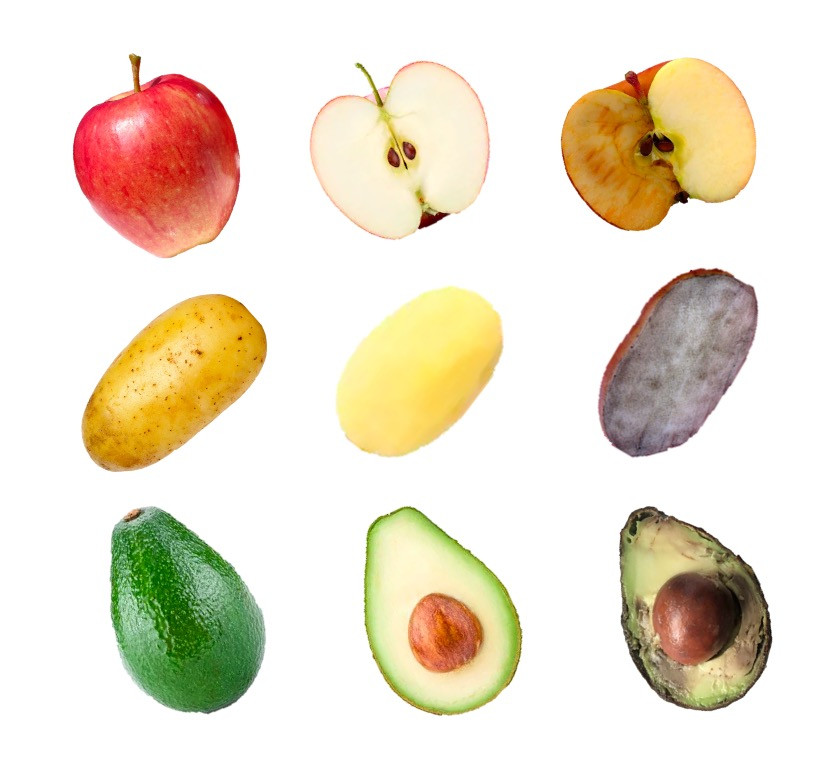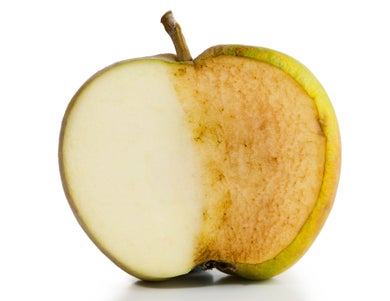Fruit Oxidation Study Guide
Introduction
Have you ever taken a sliced apple for your school lunch? If so, you would’ve noticed how it turns brown even though it was fresh, juicy, and crispy while cutting. How about a banana? Why does it turn brown when left in the open? The process they go through is known as enzymatic browning, and it happens due to the presence of an enzyme known as polyphenol oxidase.
Fruits and vegetables look fresh and juicy with their skin intact, but not all of the farm-fresh produce reach your nearby supermarket. Have you wondered why? Or why do they come with an expiration date? Fruits and vegetables like lettuce, apricots, apple, mushroom, etc., undergo enzymatic browning. This phenomenon can lead to severe degradation in product quality because no one would buy a brown banana. This is why such fruits and vegetables have a specified expiration or “best before” date.
HOW DOES IT HAPPEN?
-
The process of enzymatic browning is a slow process involving several steps.
-
PPO or polyphenol oxidase is the enzyme behind this that changes the phenolic compound present into another compound known as quinones.
-
Melanin is then produced when quinone reacts with other compounds.
-
Does melanin sound familiar to you? Yep! It is the same pigment that is responsible for maintaining your hair color, your skin color, and also the irises.
-
However, in the case of fruits and vegetables, it does not offer any productive benefit but rather degrades their value.
-
Fresh fruits and vegetables do not undergo this enzymatic browning process.
-
However, when PPO, phenolic compounds, and oxygen compounds come in contact, they trigger each other.
-
This mostly happens with sliced fruits if they fall or have been knocked around several times.
-
Due to external factors like cold, heat, and humidity, the fruit tissues get damaged, and the cell breaks down, leading to phenolic compounds being released, which then mix with oxygen.
-
Therefore, the tissue turns brown within seconds.
EXAMPLE- APPLE OXIDATION
- When you slice an apple or knock it off a few times, oxygen is introduced into the damaged plant tissues.
- With the presence of oxygen within the cells, PPO present in the chloroplasts rapidly oxidizes the phenolic compounds that you would naturally find in apples.
- This leads to O-quinones, which would form the brown color pigment by reacting with amino acids and proteins, or they could even self-assemble, creating polymers, resulting in the oxidation of apples.
Enzymatic browning at home could be reduced by preventing PPO oxidation or lowering the amount of substrate. You could coat your apples in syrup or sugar coating to reduce oxygen diffusion.
SUMMARY
- In the presence of oxygen, fresh fruits and vegetables could often brown; the phenomenon is termed enzymatic browning.
- This happens when PPO changes phenolic compounds into quinones, resulting in the release of melanin, leading to the browning of fruits.
- Enzymatic browning is unique for apples and happens in mushrooms, apricots, and bananas as well.
- You could stop the browning of apples by reducing PPO oxidation.
We hope you enjoyed studying this lesson and learned something cool about Fruit Oxidation! Join our Discord community to get any questions you may have answered and to engage with other students just like you! Don’t forget to download our app to experience our fun VR classrooms – we promise it makes studying much more fun! 😎
Sources:
- Fruits Gone Bad: https://www.scientificamerican.com/article/fruits-gone-bad-discover-enzymatic-browning/Accessed 28 Feb 2022.
- Browning in Apples: https://iubmb.onlinelibrary.wiley.com/doi/full/10.1002/bmb.21083. Accessed 28 Feb 2022.
- Why do apple slices turn brown? https://www.scientificamerican.com/article/experts-why-cut-apples-turn-brown/. Accessed 28 Feb 2022.


